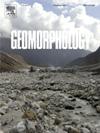Analysis of the fundamental differences between dam-forming landslides and all landslides
IF 3.1
2区 地球科学
Q2 GEOGRAPHY, PHYSICAL
引用次数: 0
Abstract
Dam-forming landslides are of significant interest to researchers, as only about 1 % of landslides block rivers, yet these dams can cause extreme flooding when they collapse, with flood flows up to ten times larger than extreme fluvial floods. While regional studies have noted differences in the dimensional characteristics and formation indices between dam-forming and non-dam-forming landslides, a global quantitative comparison has not yet been made. Using open-access global datasets, we conducted a statistical analysis of their morphometric and spatial characteristics, including volume, height/length ratio, and geomorphological factors. Spatial clustering analysis was also performed to determine whether certain landslides are more likely to form dams. The results indicate that dam-forming landslides are a distinct subset: (i) they occur in more upstream areas with higher stream power index values; (ii) they have lower mobility, confined by steeper slopes and shorter hillslope lengths; (iii) shallower landslides with larger surface area and sufficient volume are more likely to form dams; and (iv) they exhibit different spatial clustering patterns compared to general landslides. Despite some data limitations, this global study provides a foundation for quantifying a landslide dam formation index and identifying areas prone to dam formation.
求助全文
约1分钟内获得全文
求助全文
来源期刊

Geomorphology
地学-地球科学综合
CiteScore
8.00
自引率
10.30%
发文量
309
审稿时长
3.4 months
期刊介绍:
Our journal''s scope includes geomorphic themes of: tectonics and regional structure; glacial processes and landforms; fluvial sequences, Quaternary environmental change and dating; fluvial processes and landforms; mass movement, slopes and periglacial processes; hillslopes and soil erosion; weathering, karst and soils; aeolian processes and landforms, coastal dunes and arid environments; coastal and marine processes, estuaries and lakes; modelling, theoretical and quantitative geomorphology; DEM, GIS and remote sensing methods and applications; hazards, applied and planetary geomorphology; and volcanics.
 求助内容:
求助内容: 应助结果提醒方式:
应助结果提醒方式:


